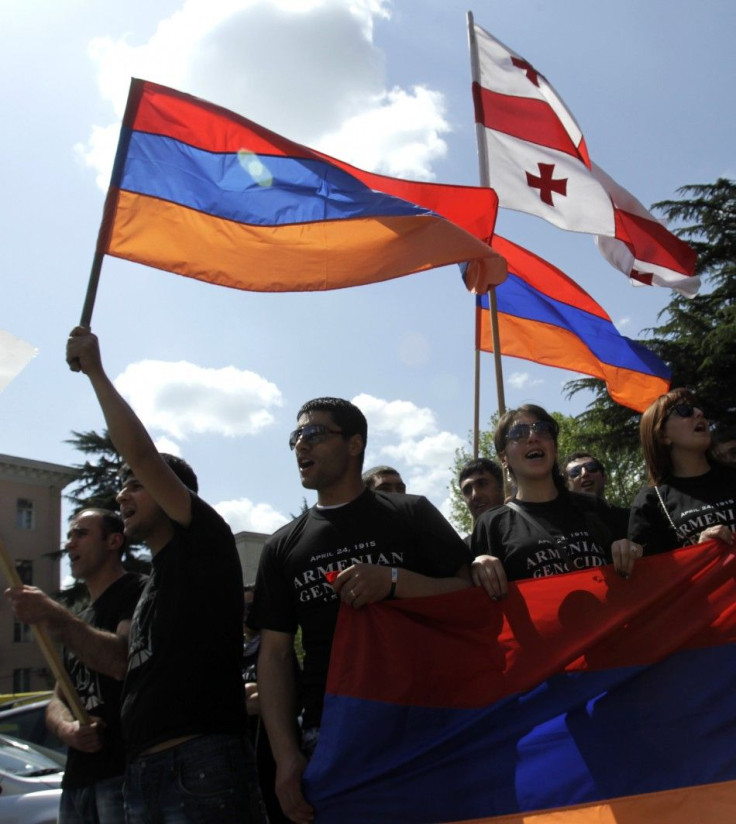The Turkish-Armenian Enmity, Boiled Down To One Dish

ISTANBUL -- Small balls of wheat crack, bubble and then settle at the bottom of the pot, absorbing water. The four-hour process forms the base of a dish that Armenians say is a staple in many of their homes, one passed down through generations. The resulting dish, known as harisa, or keshkek to Turks, is one of the last symbols of Armenian culture, according to Armenians, that has not been tainted or wiped away like so many other Armenian cultural symbols following the genocide of 1915, whose hundredth anniversary falls on Friday.
Harisa is a thick soup with a base of dried or roasted cracked wheat mixed with meat, traditionally chicken. It is not a particularly difficult meal to make. It involves only a few ingredients. But it is one of the staples in Armenian households, and long has been used as a way to bring people together. Turkey's version is cooked in cauldrons, instead of the clay ovens where Armenians make theirs.
The similarities stem from centuries of living side by side; the small post-Soviet state of Armenia and today's Turkish Republic share a border, and millions of Armenians lived under the latter's predecessor, the Ottoman Empire, until the Ottomans' genocide during World War I.
But today harisa, or keshkek, is at the center of a culinary battle brewing between Armenian and Turkish chefs. Both claim the dish, often called chicken porridge by those who eat it, is essential to their national identities. Armenians, in fact, call it their national dish, and say it's representative of a wider effort to hold on to their heritage, in the face of Turkish efforts to erase it. The culinary debate has risen to the highest ranks of government and has even landed at the United Nations.
The denial of the Armenian genocide is mirrored in the destruction and whitewashing of Armenian antiquities in the eastern part of the country -- and, chefs say, in the Turkish rhetoric surrounding the roots of harisa.
In 2011, Turkey managed to get keshkek listed in the Intangible Cultural Heritage List by Unesco. The United Nations' cultural organization says its decisions “do not recognize exclusivity or authenticity” and that “the same element can be inscribed by more than one state,” but Armenian chefs say the listing of the dish as Turkish is taking away another piece of the Armenian identity.
“We are in the middle of the war of civilizations,” said Armenian analyst Ruben Nahatakyan to ArmeniaNow in 2012 at the beginning of the movement to reclaim harisa as Armenian. “Our not-so-friendly neighbors are trying to rob the entire Armenian highland, both the territories that are part of the Armenian Republic and those that aren’t. A neighbor will always take what’s yours if you don’t protect it.”
Since 2011, Armenians have been fighting for a reversal of the Unesco decision, and are on a campaign to promote the dish as Armenian.
“Harisa is an Armenian dish,” said Grisha Antinyan, a celebrity chef in Armenia and the founder of the Preservation and Development of Armenian Culinary Traditions organization. “It's a food of remembrance. It has become part of the clash of the cultures.”
The president of Antinyan’s organization, Sedrak Mamulyan, also an Armenian chef, is the main player in the fight to reclaim harisa. He is urging the Armenian government to take the steps necessary to persuade Unesco to recognize harisa as Armenian.
“If a dish is prepared in the tonir [cylindrical clay oven], there is no doubt that it is Armenian. The homeland of the wheat is the Armenian Plateau, and this is accepted by everyone,” Mamulyan said during a press conference in 2011 after the Unesco decision.
Armenian chefs have so far failed to persuade the international community to recognize the dish as Armenian. But, leading up to the centennial commemoration, some of them have been forging partnerships with Turkish institutions to try and turn the harisa conflict into an occasion for peace -- a recognition of the fact that the dish is a shared heritage, not the property of one nation. Their efforts have become part of a regionwide movement known as gastrodiplomacy, the pursuit of detente through food.
The Food Diplomacy Project, a program run through Kadir Has University's culinary school in Istanbul, is at the center of that movement in Turkey. The school hosted Antinyan, the Armenian chef, as part of its effort to promote ties between Turkey and Armenia. The program brings in chefs from various countries to introduce their foods and share their cultures. One of the directors of the program, Yasamboyu Egitim Merkezi, said he chose Armenia as the first country to host because of the "closeness" of the Turkish and Armenian food.
Antinyan sounded a conciliatory note; the harisa-keshkek conflict may yet end in peace, at the table.
"Harisa is widespread in our region, and it is also common out of our region," he said. "No one can deny Turkey or any other nation from eating harisa."
© Copyright IBTimes 2025. All rights reserved.





















